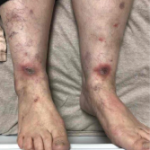Disease outcomes in rheumatoid arthritis (RA) have improved dramatically since the introduction of biologic agents and improved treatment strategies. Nevertheless, the majority of patients still require prolonged, if not lifelong, therapy. Therefore, the ultimate goal would be to prevent RA.
Before RA is diagnosed, many patients present with undifferentiated arthritis (UA) or arthralgia. Clinical trials in patients presenting with arthralgia are still scarce, but several trials have evaluated whether intervention with disease-modifying anti-rheumatic drugs (DMARDs) in UA is effective in preventing progression to classifiable RA. The results of these trials were mixed, but none showed that RA development could be prevented by early intervention with DMARDs. The finding that there was no improved outcome if disease-modifying treatment was started in the phase of UA is surprising and is in contrast to results of multiple observational studies that showed the benefit of early intervention in RA. Altogether, this raises the question of whether the principle of “the earlier the better” does not apply to the phase of UA.
A model for predicting risk of RA development in UA patients is now well established and widely replicated and offers the opportunity to identify those UA patients who have a high risk of developing RA. This model, therefore, enables postrandomization exclusion of patients without a high risk of RA. Therefore, in the present study, the researchers aimed to analyze the effect of a one-year course of methotrexate (MTX) in high-risk UA patients by reanalyzing the Probable Rheumatoid Arthritis: Methotrexate vs. Placebo Treatment (PROMPT) trial after post-randomization exclusion of patients without a high risk of developing RA.
Methods: A validated prediction model was used to determine the risk of RA in all patients included in the PROMPT trial. Patients with a prediction score of ≥8 (positive predictive value of ≥84% for developing RA) were considered to have a high risk of developing RA. The effect of a one-year course of MTX during five years of follow-up was reinvestigated in these patients.
Results: Twenty-two of the 110 patients in the PROMPT trial had a high risk of RA at baseline. In the MTX arm, six of 11 patients (55%) developed RA, compared with 11 of 11 patients (100%) in the placebo arm (P=0.011). Time to RA development was longer in the MTX arm than in the placebo arm (median 22.5 months vs. three months; P<0.001). Drug-free remission was achieved by four of 11 patients (36%) in the MTX arm compared with 0 of 11 patients (0%) in the placebo arm (P=0.031). These beneficial effects of MTX were observed both in anti-citrullinated protein antibody (ACPA) positive and in ACPA-negative UA patients with a high risk of RA, but not in UA patients without a high risk of RA. In retrospect, 43 of 110 patients fulfilled the ACR/EULAR 2010 classification criteria for RA at baseline. In addition, beneficial effects were observed only in patients with a high prediction score.
Conclusion: A one-year course of MTX delayed and prevented RA development in high-risk UA patients. This emphasizes the importance of adequate risk prediction in trials that aim to prevent RA.
Excerpted and adapted from:
Burgers LE, Allaart CF, Huizinga TWJ, et al. Clinical trials aiming to prevent rheumatoid arthritis cannot detect prevention without adequate risk stratification: Using a trial of methotrexate versus placebo in patients with undifferentiated arthritis as an example. Arthritis Rheumatol. 2017 May;69(5):926–931.
